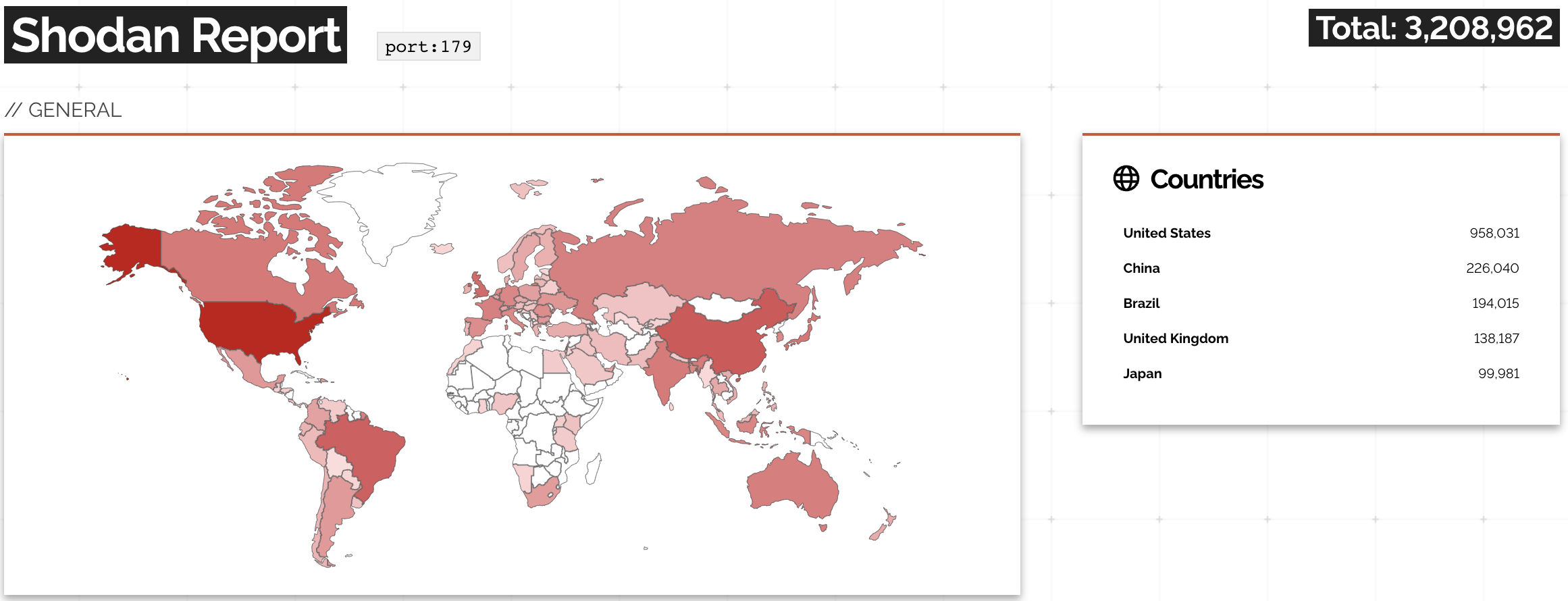Open BGP Daemons: There’s So Many of Them
A while ago, the Networking Notes blog published a link to my “Will Network Devices Reject BGP Sessions from Unknown Sources?” blog post with a hint: use Shodan to find how many BGP routers accept a TCP session from anyone on the Internet.
The results are appalling: you can open a TCP session on port 179 with over 3 million IP addresses.

A report on Shodan opening TCP session to port 179
MPLS TE Deadlock
The post MPLS TE Deadlock appeared first on Noction.
AI Is Making Data Cost Too Much

You may recall that I wrote a piece almost six years ago comparing big data to nuclear power. Part of the purpose of that piece was to knock the wind out of the “data is oil” comparisons that were so popular. Today’s landscape is totally different now thanks to the shifts that the IT industry has undergone in the past few years. I now believe that AI is going to cause a massive amount of wealth transfer away from the AI companies and cause startup economics to shift.
Can AI Really Work for Enterprises?
In this episode of Packet Pushers, Greg Ferro and Brad Casemore debate a lot of topics around the future of networking. One of the things that Brad brought up that Greg pointed out is that data being used for AI algorithm training is being stored in the cloud. That massive amount of data is sitting there waiting to be used between training runs and it’s costing some AI startups a fortune in cloud costs.
AI algorithms need to be trained to be useful. When someone uses ChatGPT to write a term paper or ask nonsensical questions you’re using the output of the GPT training run. Continue reading
How Data Center Infrastructures Must Change to Support AI
How are enterprises big and small adapting their data center infrastructure to handle AI workloads?Understanding the Role of the Network in Sustainability
Extreme Networks is embracing a multi-pronged sustainability strategy to achieve its environmental objectives for the company itself and its networking solutions.Rapid Progress in BGP Route Origin Validation
In 2022, I was invited to speak about Internet routing security at the DEEP conference in Zadar, Croatia. One of the main messages of the presentation was how slow the progress had been even though we had had all the tools available for at least a decade (RFC 7454 was finally published in 2015, and we started writing it in early 2012).
At about that same time, a small group of network operators started cooperating on improving the security and resilience of global routing, eventually resulting in the MANRS initiative – a great place to get an overview of how many Internet Service Providers care about adopting Internet routing security mechanisms.
Rapid Progress in BGP Route Origin Validation
In 2022, I was invited to speak about Internet routing security at the DEEP conference in Zadar, Croatia. One of the main messages of the presentation was how slow the progress had been even though we had had all the tools available for at least a decade (RFC 7454 was finally published in 2015, and we started writing it in early 2012).
At about that same time, a small group of network operators started cooperating on improving the security and resilience of global routing, eventually resulting in the MANRS initiative – a great place to get an overview of how many Internet Service Providers care about adopting Internet routing security mechanisms.
Getting Aggressive with Cloud Cybersecurity
Cloud cybersecurity should be addressed proactively in order to detect lurking vulnerabilities before threat actors can attack. Here’s what IT leaders need to know to get the upper hand on cloud cybersecurity.Tech Bytes: How VMware And HPE Greenlake Tackle AI And Multi-Cloud For Customers (Sponsored)
VMware and HPE are partnering on HPE Greenlake for VMware Cloud Foundation. On today's episode we discuss how the HPE and VMware partnership benefits customers’ multi-cloud initiatives and how VMware and HPE Greenlake can help customers take advantage of AI by providing scalable hardware and software infrastructure for training and inference. VMware is our sponsor.
The post Tech Bytes: How VMware And HPE Greenlake Tackle AI And Multi-Cloud For Customers (Sponsored) appeared first on Packet Pushers.
Tech Bytes: How VMware And HPE Greenlake Tackle AI And Multi-Cloud For Customers (Sponsored)
On today’s Packet Pusher’s Tech Bytes podcast, sponsored by VMware, the conversation delves into HPE’s partnership with VMware, particularly around HPE Greenlake for VMware Cloud Foundation. HPE was recently recognized as VMware’s 2023 partner of the year. Today’s podcast features an interview with Frances Guida, Director, Compute Workload Solutions Product Management at HPE. The podcast... Read more »NB454: Is Bad InfoSec Now Securities Fraud?
On today's Network Break we discuss potential repercussions for security executives after the SEC charges Solar Winds' CISCO with fraud, examine a new SD-LAN offering from Versa Networks that aims to integrate security controls into a campus fabric, and look at a new open-source tool from Cloudflare for scrubbing sensitive authentication tokens from HAR files.
The post NB454: Is Bad InfoSec Now Securities Fraud? appeared first on Packet Pushers.
NB454: Is Bad InfoSec Now Securities Fraud?
We discuss potential repercussions for security executives after the SEC charges Solar Winds’ CISCO with fraud, examine a new SD-LAN offering from Versa Networks that aims to integrate security controls into a campus fabric, and discuss a new open-source tool from Cloudflare for scrubbing sensitive authentication tokens from HAR files. Extreme Networks posts strong revenues... Read more »DCAUTO Exam Experience by Nick Russo
On 17 October 2023, I took and passed the Automating and Programming Cisco Data Center Solutions (DCAUTO) exam on my first attempt. This is the seventh DevNet exam I’ve passed. After the retirement of the Webex and IoT specialty exams, the Collaboration specialty and Expert exams remain the only two I haven’t attempted. Much like my experience with enterprise, service provider, and security automation, I have years of real-life experience automating various data center solutions, primarily by working with Nexus and NDO (formerly MSO). I’ve spoken about the topic on various podcasts and professional training courses many times. Believe it or not, I don’t have as much real-life automation experience with ACI or UCS, which are key data center products for Cisco, so I studied those areas intensely.
It’s worth mentioning that Cisco’s new certification road map introduces small changes at regular intervals to all of their certification exams. This is smart as it leads to less “blueprint shock” every few years, plus gives learners an opportunity to master the newest technologies in an incremental way. Because Cisco updated DCAUTO earlier this year, I took the v1.1 exam. I’m not kidding when I say the exam was Continue reading
Fibre Channel Addressing
Whenever we talk about LAN data-link-layer addressing, most engineers automatically switch to the “must be like Ethernet” mentality, assuming all data-link-layer LAN framing must somehow resemble Ethernet frames.
That makes no sense on point-to-point links. As explained in Early Data-Link Layer Addressing article, you don’t need layer-2 addresses on a point-to-point link between two layer-3 devices. Interestingly, there is one LAN technology (that I’m aware of) that got data link addressing right: Fibre Channel (FC).
Fibre Channel Addressing
Whenever we talk about LAN data-link-layer addressing, most engineers automatically switch to the “must be like Ethernet” mentality, assuming all data-link-layer LAN framing must somehow resemble Ethernet frames.
That makes no sense on point-to-point links. As explained in Early Data-Link Layer Addressing article, you don’t need layer-2 addresses on a point-to-point link between two layer-3 devices. Interestingly, there is one LAN technology (that I’m aware of) that got data link addressing right: Fibre Channel (FC).
Non-interactive SSH password authentication
SSH offers several forms of authentication, such as passwords and public keys. The latter are considered more secure. However, password authentication remains prevalent, particularly with network equipment.1
A classic solution to avoid typing a password for each connection is sshpass, or its more correct variant passh. Here is a wrapper for Zsh, getting the password from pass, a simple password manager:2
pssh() { passh -p <(pass show network/ssh/password | head -1) ssh "$@" } compdef pssh=ssh
This approach is a bit brittle as it requires to parse the output of the ssh
command to look for a password prompt. Moreover, if no password is required, the
password manager is still invoked. Since OpenSSH 8.4, we can use
SSH_ASKPASS and SSH_ASKPASS_REQUIRE instead:
ssh() { set -o localoptions -o localtraps local passname=network/ssh/password local helper=$(mktemp) trap "command rm -f $helper" EXIT INT > $helper <<EOF #!$SHELL pass show $passname | head -1 EOF chmod u+x $helper SSH_ASKPASS=$helper SSH_ASKPASS_REQUIRE=force command ssh "$@" }
If the password is incorrect, we can display a prompt on the Continue reading
Worth Reading: Confusing Git Terminology
Julia Evans wrote another great article explaining confusing git terminology. Definitely worth reading if you want to move past simple recipes or reminiscing about old days.
Worth Reading: Confusing Git Terminology
Julia Evans wrote another great article explaining confusing git terminology. Definitely worth reading if you want to move past simple recipes or reminiscing about old days.
